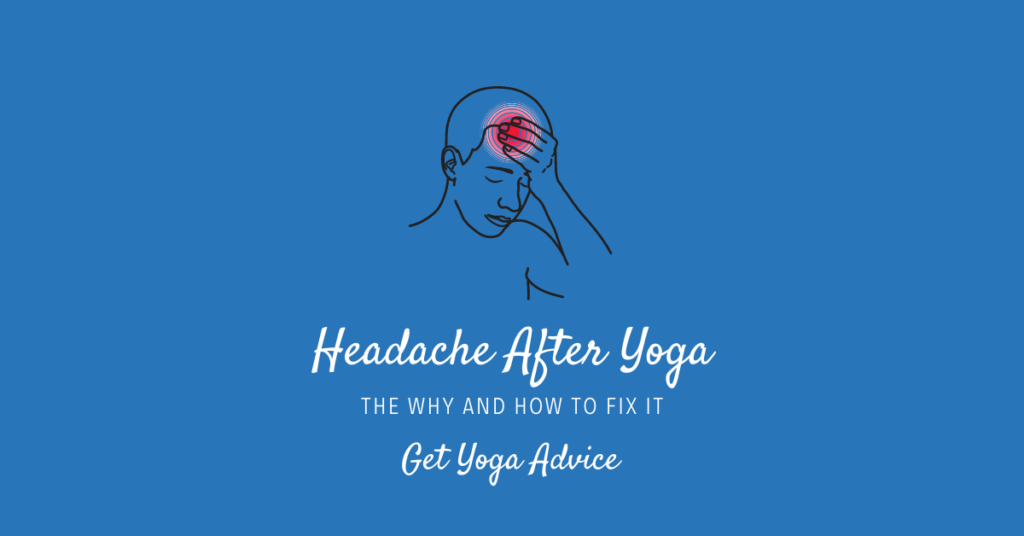The practice of yoga is designed to calm your mind and body. Categorized as a low impact exercise, yoga is still incredibly demanding on our muscles. The strength and balance required to perform and hold some poses is deceiving.
A successful practice should leave you feeling refreshed, energized, and with improved mental clarity. Why then do some of us walk away with a throbbing headache? Rest assured, this is very common and is easily remedied.
There are a number of reasons why you might suffer from a headache after yoga. The most obvious culprit is dehydration. Other causes include incorrect alignment, low blood sugar, and simply arriving to class unprepared or rushed.
Let’s take a closer look at what causes headaches after yoga and find out how to alleviate and prevent this painful inconvenience.
Contents
Common Causes of Headache After Yoga
1. Dehydration
Drinking water is the easiest way to stay hydrated. On average, adults should drink at least 8 cups of water. This is a general suggestion.
When you include exercise into your day, you need to replenish the water lost from your body when you perspire. Drinking water before, during, and after your yoga practice is the first step in eliminating a headache caused by dehydration.
Avoid drinking coffee, drinks that contain caffeine, or drinks with added sugar.
If you are practicing hot yoga, we suggest an intake of at least two bottles of water during your practice. The increased heat and perspiration will cause severe dehydration if you are not replenishing with water.
Healthline has some excellent guidelines on water intake depending on your age and lifestyle.
2. Caffeine
Coffee or any caffeinated beverage can have adverse effects on our blood flow. There is nothing wrong with starting your day with a nice cup of coffee or tea. For many of us, it’s less about the caffeine and more about the ritual of enjoying a warm drink upon wake up.
The problem is when we have too much of a good thing. Caffeine can increase our blood flow and too much caffeine can send our blood flow into overdrive. When combined with a yoga class, you might experience a throbbing headache as a result.
Try to avoid drinking too much caffeine, especially before a class.
3. Muscle Tension

Headaches can cause pain in different areas of your head. A tension headache is most common and feels like a tight band around your head. It can cause mild to moderate pain.
Upon completion of yoga practice or shortly thereafter, the onset of a tension headache is most likely because you are holding tension during certain poses. Most people hold tension in their neck and shoulders, which cuts off blood flow and oxygen to your muscles.
If you feel stiff or sore during a pose, or find that you are holding your breath, try to relax or modify your pose so that you can breathe deeply. Each inhale and exhale will help to release tension and improve blood flow to your muscles.
A yoga practice without unnecessary muscle tension should eliminate post practice headaches.
If you are concerned about the frequency of your tension headaches, please take a look at what else might be causing this pain. The Mayo Clinic is an excellent free resource, but we always encourage you to seek the advice of a medical professional.
4. Incorrect Alignment
Even the most practiced yogis need alignment correction from time to time. Incorrect alignment can cause unnecessary tension and decreased blood flow. Maybe you’re bending your neck too far or arching your back too much.
Everyone’s practice is individual. It is not worthwhile to push yourself if your body is not ready. Take advantage of mirrors and the advice of a yoga instructor. Learning proper alignment for each pose, specifically for your body and flexibility, will prevent headaches.
5. Low Blood Sugar
Are you exercising on an empty stomach? A headache that follows a yoga practice might be caused by low blood sugar. With no food to fuel your body, a series of yoga poses will deplete whatever blood sugars are available, leaving you with a painful headache and possible dizziness and nausea.
If you’re thinking to yourself, I don’t want to eat a full meal before an intense yoga practice, we don’t blame you. We suggest eating a snack that is high in protein and low in carbs and sugar. A banana, loaded with potassium, is also a great option.
6. Low Sodium Levels

What is your salt intake like? A lack of salt in your diet might be a culprit if you find yourself suffering from a headache after yoga.
Our bodies lose salt when we perspire. Despite the fear that too much salt can be bad for you, which is true, including real salt in your diet will provide your body with the necessary levels of sodium to perform best.
Table salt is stripped of some important minerals. Instead look for sea salt, or Himalayan salt.
7. Rushed Lifestyle
Most of us are moving through life at an accelerated speed. Everyone is busy and rushed. Do you feel like you are always running late, or never have enough time? Are you arriving to your yoga practice with minutes or maybe only seconds to spare?
We know the feeling. If you don’t give your mind and body time to transition from one activity to the next, in this case from a busy day at work to a calm and quiet yoga practice, your body might retaliate with a painful headache.
Even giving yourself five extra minutes to sit in your car before you walk into the yoga studio can help your mind make the necessary shift. Your body will follow in turn.
8. Over Exertion
Are you practicing too much? This can be difficult to evaluate, especially if you are experiencing many of the positive benefits of a consistent yoga practice. Even so, you can still have too much of a good thing.
Try spacing out your yoga practice so that you have some time (a day or days) in between to allow your body to heal. Over exertion of any kind of exercise can cause headaches. Slowly over time you can increase how often you practice. Pace yourself and follow your body’s natural cues.
9. Other Causes
If you have made some adjustments to your yoga practice and you still find that you’re suffering from headaches, we encourage you to seek the advice of a medial professional.
The adage, no pain, no gain, can be incredibly misleading. If you are just starting out with this practice, it might take some time for your body to get used to this form of breathing and exercise. Respect your body and give yourself the necessary time to adapt.
Final Word on Headaches After Yoga
A headache is your body’s natural way of letting you know that something is not right. It is not uncommon to experience a headache after you exercise, but it should not be a frequent occurrence.
The first place to look is at your hydration. Do you drink enough water? Not just during your practice, but before and after? Next, take a look at where you are holding the most tension and whether or not this is affecting your alignment.
Do you eat before your practice? Low blood sugar is another culprit. Most importantly, are you giving your mind and body enough time to prepare for your yoga practice?
Transitioning from one activity to another takes time. Be kind to yourself and kind to your body.



